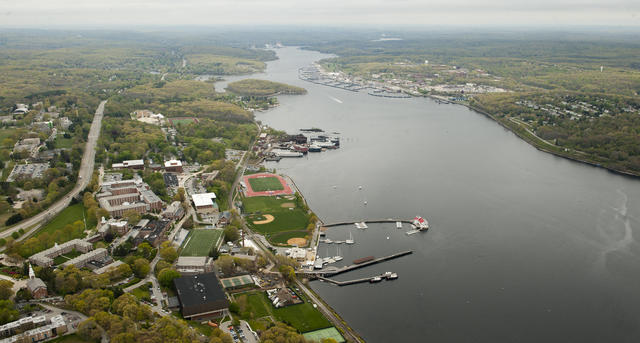Home » Regions » North America » Eastern Temperate Forests » Mixed Wood Plains » Northeastern Coastal Zone » Long Island Sound Coastal Lowland
Long Island Sound Coastal Lowland
Last updated: July 25th, 2020
↑About the Long Island Sound Coastal Lowland
The Long Island Sound Coastal Lowland is a region stretching along the southern coast of New England where it fronts on Long Island Sound rather than directly opening to the ocean, and also encompassing much of the northwestern portion of Long Island. It includes parts of New York State (on Long Island and a small stretch of coast), the entire southern coast of Connecticut, and a small portion of coast in Rhode Island.The underlying material in most of this region is glacial till, contrasting with the sandier terminal moraines and outwash making up the barrier islands and southeastern parts of Long Island. This allows for richer soils that hold moisture and organic matter better than on the sandier regions to the east and south. The climate here is humid and temperate, intermediate between the humid continental climates farther inland and the humid subtropical climates farther south. The presence of the sound and also proximity to the ocean moderates the climate. Precipitation is roughly evenly distributed throughout the year and is high overall, although slightly lower than the higher-elevation areas inland from here.
This region originally supported a unique variant of Appalachian forests. Dominant trees included tuliptree (Liriodendron tulipifera), black oak (Quercus velutina), northern red oak (Quercus rubra), American beech (Fagus grandifolia), sweet birch (Betula lenta), and red maple (Acer rubrum), with flowering dogwood (Cornus florida) as an important understory tree. Many more southerly tree species also reach their northern limits here, including American holly (Ilex opaca), post oak (Quercus stellata), American sweetgum (Liquidambar styraciflua), and common persimmon (Diospyros virginiana). Sweetgum and pin oak (Quercus palustris) were common around kettle ponds.
This area has been heavily urbanized, with both urban and industrial development, and extensive suburbanization. Little forest cover remains, mostly in small, isolated parks and preserves, and where low-density suburban development preserved some of the forests. Forest cover is greatest in the inland parts of this region in Connecticut and Rhode Island, farther from New York City.
This area has a major problem with invasive plant species, due to a combination of factors including heavy suburbanization, which fuels escape of introduced species from landscaping, and little remaining wild land, which reduces the seed source of native species. Many invasive species also thrive in the disturbed and fragmented habitats that are most common throughout this region. The mild climate and richer soils also make it easier for a range of different species to become established here than colder areas to the north or sandier areas to the southeast.
On Long Island, this area is bordered to the east by the Cape Cod / Long Island region, and to the south by the Barrier Islands/Coastal Marshes. Along Long Island Sound, it is bordered to the north by the Southern New England Coastal Plains and Hills, except near the Connecticut river where it is instead bordered by the Connecticut Valley. Along the coast of Rhode Island, it is bordered to the east by the Narragansett/Bristol Lowland.
 This aerial photo shows the Thames river in New London, CT, and the area around the US Coast Guard Academy. This region is more forested than most of the region, but it still shows urbanization and a relatively flat landscape with abundant water, typical of the area. Photo © US Coast Guard Academy, Public Domain, Source.
This aerial photo shows the Thames river in New London, CT, and the area around the US Coast Guard Academy. This region is more forested than most of the region, but it still shows urbanization and a relatively flat landscape with abundant water, typical of the area. Photo © US Coast Guard Academy, Public Domain, Source.Plant Lists & In-Region Search
We do not yet have data to generate plant lists for a region as fine-tuned as this one. However you can move up to the broader Northeastern Coastal Zone and generate lists for that region: native plants or all plants. Or search that region's plants here:
↑References
1. Griffith, G.E., Omernik, J.M., Bryce, S.A., Royte, J., Hoar, W.D., Homer, J.W., Keirstead, D., Metzler, K.J., and Hellyer, G. "Ecoregions of New England (Poster)", U.S. Geological Survey (2009) Web.
2. Bryce, S.A., Griffith, G.E., Omernik, J.M., Edinger, G., Indrick, S., Vargas, O., and Carlson, D. "Ecoregions of New York (Poster)", U.S. Geological Survey (2010) Web.


